Maintaining a lush, healthy lawn is every gardener’s dream. However, achieving this requires more than just regular mowing and watering. One essential tool for lawn care that often gets overlooked is the scarifier. In this post, we’ll explore why you should be using a scarifier for your lawn, how it benefits your grass, and some tips on how to use it effectively.
What is a Lawn Scarifier?
A lawn scarifier is a machine designed to remove thatch—a fine layer of old grass stems, dead moss, and other debris that accumulates on your lawn over time. This thatch can prevent water and nutrients from reaching the soil and hinder proper grass rooting, potentially suffocating your lawn. Scarifiers can be manual or electric and function much like a high-powered rake, helping to aerate the soil and promote healthier, weed-free, and longer-lasting grass.
Benefits of Using a Scarifier
1. Improved Soil Aeration
A scarifier cuts through the soil, creating space for air, water, and nutrients to penetrate deep into the roots of the grass. This process enhances soil aeration, which is crucial for the health and growth of your lawn.
2. Thatch Removal
Thatch, composed of dead grass, moss, and other debris, can block essential nutrients from reaching the soil. By removing this layer, a scarifier ensures that your grass can access the resources it needs to thrive.
3. Enhanced Grass Growth
By removing thatch and aerating the soil, a scarifier promotes healthier and denser grass growth. The grass can root more deeply and evenly, leading to a more resilient and lush lawn.
4. Weed and Moss Control
Regular scarifying can help prevent the buildup of moss and weeds, which thrive in compacted soil and thatch. A healthier lawn is less susceptible to these invasive plants.
When to Use a Scarifier
The ideal time to scarify your lawn is in the autumn, after the grass has been subjected to the wear and tear of summer. This timing allows your lawn to recover and strengthen before the colder winter months. It’s recommended to scarify only once a year to avoid putting too much stress on the grass and its roots.
How to Use a Lawn Scarifier
1. Prepare Your Lawn
Before scarifying, inspect your lawn for any live moss. Apply a moss killer a few weeks in advance to ensure it’s dead before scarifying. Dead moss will appear black or brown and dry.
2. Mow Your Lawn
On a dry day, mow your lawn on a low setting. This makes it easier for the scarifier to penetrate the soil.
3. Scarify on a High Setting
Start with the scarifier on a high setting and go over the lawn a couple of times. Then, repeat the process at different angles, lowering the settings with each pass.
4. Overseed and Top Dress
After scarifying, your lawn might look a bit worn out. Overseed the lawn by adding grass seed and covering it with a topsoil layer, like Miracle-Gro Lawn Dressing, to protect the seeds as they germinate.
Are There Alternatives to Scarifiers?
For smaller lawns or those who prefer a more hands-on approach, a spring tine garden rake can be used as an alternative to a scarifier. While it requires more effort and time, it allows for more control over the pressure applied and provides good exercise.
Conclusion
Incorporating a scarifier into your lawn care routine can significantly improve the health and appearance of your grass. By removing thatch, enhancing soil aeration, and promoting stronger grass growth, a scarifier helps you maintain a lush, green lawn. Remember to scarify in the autumn and follow the preparation and aftercare steps for the best results. Happy gardening!

